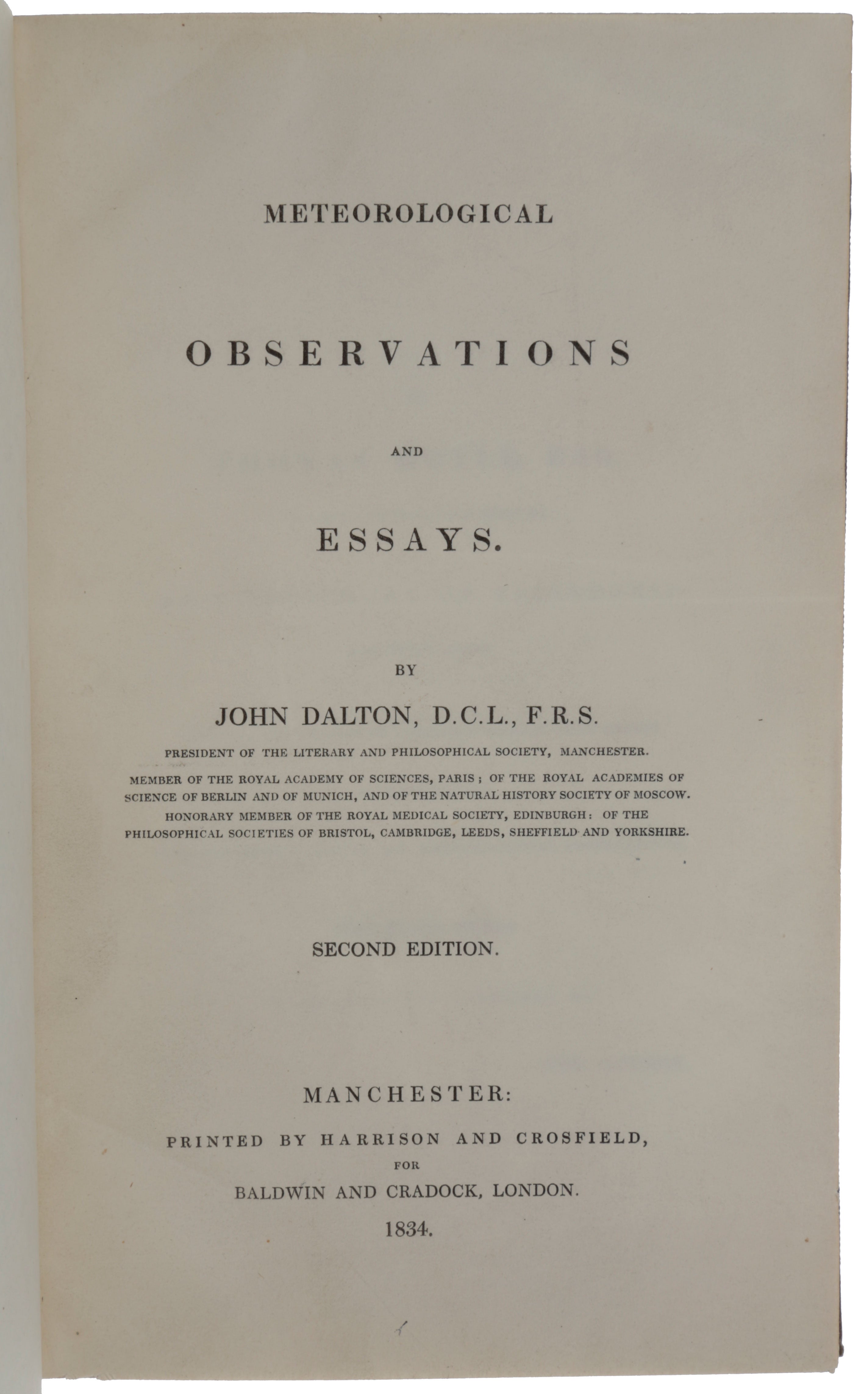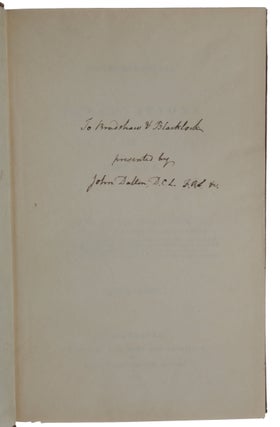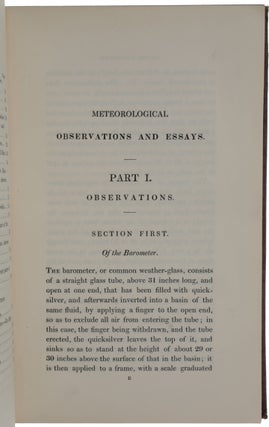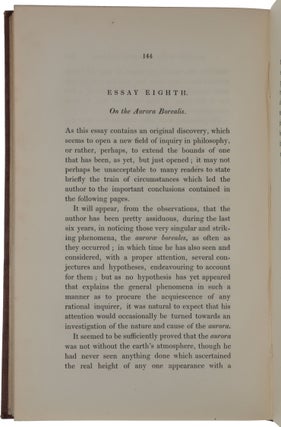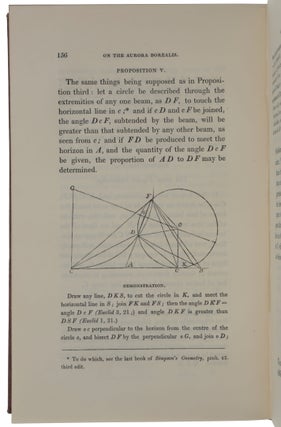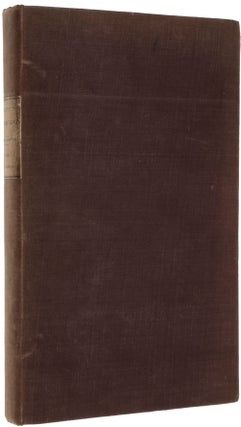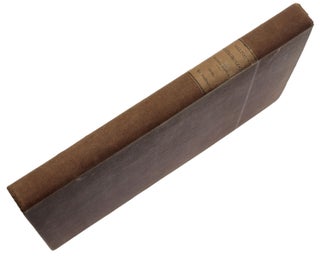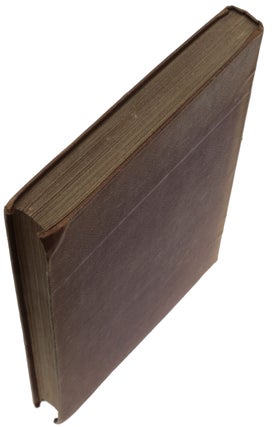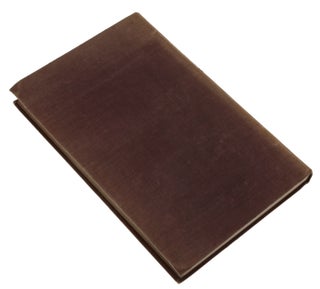Meteorological Observations and Essays.
Manchester: Printed by Harrison and Crosfield for Baldwin and Cradock, 1834. Second edition (first, 1793), inscribed by Dalton, of Dalton’s first book which, according to Dalton himself, “contained the germs of most of the ideas afterwards expanded by him into discoveries” (DNB V, 428-34). Dalton (1766-1844) is famous today for his atomic theory of matter, but this grew out of his early work on meteorology, which resulted in his Meteorological Observations and Essays. “It created little stir at first but contained original ideas that, together with Dalton’s more developed articles, marked the transition of meteorology from a topic of general folklore to a serious scientific pursuit” (Britannica). In this book Dalton stated that “water evaporated is not chymically combined with the aerial fluids but exists as a peculiar fluid diffused amongst the rest,” and that “when a particle of vapour exists between two particles of air let their equal and opposite pressures upon it be what they may, they cannot bring it nearer to another particle of vapour.” “The ideas that in a mixture of gases every gas acts as an independent entity (Dalton’s law of partial pressures) and that the air is not a vast chemical solvent were thus first stated in the Meteorological Observations” (DSB). “Dalton’s first scientific experiments stemmed from his life-long interest in meteorology … One of his most important scientific conclusions was that water is a component of air at all temperatures, and he produced a table of the vapour pressure of water at different temperatures from his own experiments. This work led on to what is now called the Law of Partial Pressures … In lectures to the Royal Institution in 1810 Dalton himself attributed the origins of his atomic theory to his studies on the properties of mixed gases” (Lappert & Murrell, p. 3817). Meteorological Observations “contained not only a record of his unremitting observations but also inferences of the causes of the meteorological phenomena so exposed. These reflections, which inevitably concerned the relation between air, water, and water vapour, played an important part in the evolution of his future theories … The book began with a description of the instruments needed for observation. There followed a series of typical observations and essays on their interpretation. Then a more interesting section on the aurora showed Dalton’s breadth of experience with many instruments, even including work with a new design of theodolite. The final section interpreted the findings of the earlier sections, offering theories and speculations, including one of great ingenuity—proposing that the aurora is of electrical or magnetic origin” (DNB). Provenance: The Manchester publishers Bradshaw & Blacklock (inscribed ‘To Bradshaw & Blacklock presented by John Dalton D.C.L., F.R.S. &’ on front free endpaper). By 1839, Bradshaw & Blacklock had moved premises to 27 Brown Street, from where they published their famous railway guides. Dalton and George Bradshaw attended the same Manchester Quaker’s Meeting House. “John Dalton was born in the village of Eaglesfield a few miles from Cockermouth in Cumbria and his house, though altered, is still there marked with a plaque. His Quaker family was initially extremely poor but his father was able to teach him mathematics, and John attended the Friends school until he was 12 years old. Such was his progress that, when his teacher left, John took over the school himself. During this period he also obtained a thorough grounding in mathematics under the tuition of a gentleman who lived nearby. In 1781John was asked to teach at a Quaker school in Kendal, jointly with his brother. After taking advice from the Council of Friends this was agreed. He walked to Kendal carrying one of the new umbrellas which had just become available in Cockermouth. When their cousin who ran the school left in 1785 the two brothers took over with the help of their sister, who came to keep house. Their advertisements proudly state that the school ‘has a valuable library of books on history, mathematics and natural philosophy, also an air pump, globes and several other philosophical, mathematical and optical instruments’. “It was during his time at Kendal that Dalton began his life-long interest in things meteorological, stimulated by his contacts with the blind scientist John Gough who gave him the run of his library and with whom he had frequent scientific discussions. In 1793, following an invitation from Dr Thomas Barnes, Principal of the New College Manchester (now moved to Oxford University as Harris Manchester College), Dalton took up the position of which he held until 1800. It was during his time there that he produced some of his most important meteorological work. After leaving the college Dalton continued to live simply in Manchester, spending his time teaching and researching on subjects within and far beyond natural philosophy. He presented papers to, and played an increasingly important role in, the Manchester Literary and Philosophical Society, with an extended period as its President. Public acclaim led to lecture tours around the UK and abroad and to the award of many honours, including an FRS, various degrees and eventually a Government pension. On his death the Manchester Corporation mounted a vast funeral with a mile-long procession attended by 40 000 mourners. As a person Dalton lived modestly and never lost his rustic accent and his simple Quaker approach to life. In addition to Quaker activities on Sundays, he allowed himself just one afternoon of relaxation each week to play bowls. He never married, his main excuse being ‘I never had the time’. He never really adapted to the social expectations of international fame and continued with basic tutoring throughout his life. The rigid pattern of his life and his meticulous approach to measurement and research made him an ideal meteorological observer. “During his years at Kendal, Dalton refined the skill of making barometers and began taking regular meteorological observations. His thermometer was situated ‘without, in a garden, under the shade of a rather large gooseberry tree facing north: the garden is open to the countryside to the north and has houses at a distance of 8 or 10 yards [7 or 9m] to the south’. His observations were taken between 0600 and 0800LT [local time], 1200 and 1300LT, and 2100 and 2200LT. A friend, Peter Crossthwaite, took broadly similar measurements at Keswick. He used a whipcord hygrometer whose length was humidity dependent and a 10in (250mm) diameter rain gauge ‘sufficiently distant from trees, houses &c’ … “After his time at Kendal Dalton published his book Meteorological observations and essays (1793). This was primarily intended as a meteorological textbook and was in two sections. The first gave details of meteorological measurement techniques and listed monthly values for Kendal and Keswick, together with London data from the Royal Society, all with appropriate comments. Articles giving data on cloud heights, wind, duration of snow-cover and appearances of the aurora (then generally considered to be a meteorological phenomenon) were also included. The second half of the book aimed to provide students with explanations of meteorological data and processes, partly original and partly reproduced from previously published sources, with several chapters on the aurora. The chapter on evaporation is especially relevant to later work as he describes evaporation experiments and concludes that ‘water evaporated is not chymically combined with the aerial fluids but exists as a peculiar fluid diffused amongst the rest’. At that time it was not necessarily accepted that water vapour has a separate existence in the atmosphere. The book was published by public subscription and Dalton republished it, with almost no changes, some 40 years later” (Oliver, p. 208). “Many of Dalton’s diaries can now be found at the John Rylands Library at the University of Manchester. As well as the classic Mancunian wind and rain, he also documented sightings of the aurora borealis. Sometimes the entries were cursory, such as the ‘large crimson light’ noted on 11 May 1788. Particularly strong showings, however, often moved Dalton to indulge his literary side. One event over Kendal in October 1792, for instance, was said to ‘surpass all description’. As any good scholar would, he assembled an arsenal of adjectives and tried his best to describe it anyway: ‘The intensity of the light, the prodigious number and volatility of the beams, the grand intermixture of all the prismatic colours in their utmost splendour, variegating the glowing canopy with the most luxuriant and enchanting scenery, affording an awful, but at the same time, the most pleasing and sublime spectacle in nature. Everybody gazed with astonishment.’ “In Dalton’s time, the cause and origins of the aurora borealis were unclear. In 1716, people in Yorkshire and London swore they saw glimpses of giant armies fighting in the heavens amidst the unpredictable, colourful lights. This was the time of Jacobite rebellion, of sectarian violence in England. The aurora was seen by some as a dire portent about the perils of rising tensions and violence. “Dalton was among a small group of scholars who began to look for a scientific explanation for the aurora borealis. He was sometimes disparaging about the theories of his contemporaries, referring to them as ‘extravagant’ and ‘ridiculous’. After years of careful observation, John Dalton suspected that the aurora had an electrical or magnetic origin. He was so curious about the origins of the aurora borealis that he began testing his theories using scientific approaches and instruments. Dalton rambled and traipsed around the Lake District (Kendal and Keswick) with homemade kit to make recordings and document his observations. He used his theodolite—a surveying instrument with a rotating telescope to measure angles—to correctly estimate the distance of the aurora from the surface of the earth. Dalton suggested that the aurora occurred at least 60 miles (approximately 100 kilometres) up into the atmosphere (it actually occurs between 100 and 200 kilometres in the mesosphere, or middle layer, of the atmosphere. Commercial planes usually fly at 11 kilometres.) Dalton also used a dip needle—a kind of compass that reveals angles and movements of magnetic fields—to test his hypothesis about connections between the aurora on the Earth’s magnetic field. When the aurora appeared, Dalton noticed a slight disturbance in his instrument—the needle moved. He used his observations to create a theory that claimed a magnetic or electric origin for auroral lights. “We now know that charged solar particles generate an opposite polarity to the Earth. This energy weakens and depresses the Earth’s magnetic field. As the aurora appears when these particles bombard the atmosphere, Dalton was able to pick up on these slight changes in magnetic field lines on the Earth’s surface. He wasn’t sure why the aurora was occurring, but by being out there and testing his ideas, he was able to generate new ideas. John Dalton’s ideas were cutting edge for the time. He was actually worried that his ideas were so ‘wild and chimerical’ that the scientific community would not believe him, but he had confidence in his data and observations. At the time, scientific understanding of magnetism was limited. It was something that people had started to observe, bit it was not well understood. This might explain Dalton’s incorrect suggestion that the Earth’s magnetism pulled an elastic, magnetic fluid across the sky to create the beams of light. Dalton thought that these magnetic beams or fluid contained iron that was pulled towards the Earth’s magnetic poles. He also suggested that the aurora could be similar to the ‘discharges of fluid in the atmosphere… [as with] the phenomenon of lightning’. Although other people such as Edmund Halley had suggested an electrical or magnetic origin for the aurora, Dalton was one of the very first people to test these ideas in a scientific way. His pioneering ideas and research were not taken seriously by other scientists for decades” (Leech). Lappert & Murrell, ‘John Dalton, the man and his legacy: the bicentenary of his Atomic Theory,’ Dalton Transactions (2003), 3811-20. Leech, ‘John Dalton and the Aurora Borealis,’ Science and Industry Museum (blog.scienceandindustrymuseum.org.uk/john-dalton-aurora-borealis/). Oliver, ‘Meteorologist’s profile – John Dalton,’ Weather 58 (2003), pp. 206-211. Wheeler Gift 582; Norman 574 (both for 1st ed.).
8vo (227 x 140 mm). xx, 244, [4] pp., including publisher's advertisements on final [4] pages. Original publisher’s boards, printed paper label on spine. A fine copy.
Item #4946
Price: $2,500.00

